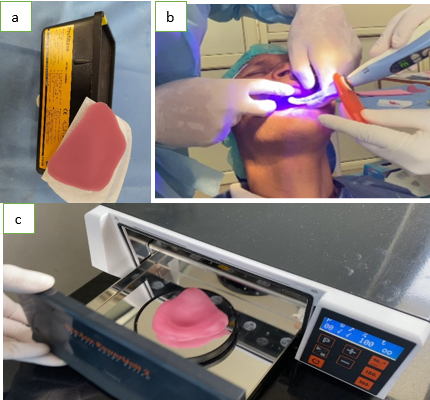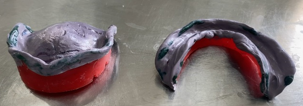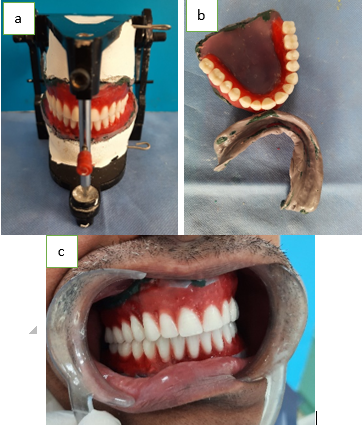- Visibility 75 Views
- Downloads 5 Downloads
- DOI 10.18231/j.idjsr.2022.005
-
CrossMark
- Citation
Faster, convenient & effective: the single appointment complete denture: A new dental technique
- Author Details:
-
Ranjoy Hazra *
-
Ayush Srivastava
-
Dinesh Kumar
Introduction
Edentulism has been a serious public health problem due to population aging and poor oral care. Conventional complete dentures are the mainstay choice for edentulous patients. The demand for complete dentures will continuously increase in the next decades. Conventional complete denture fabrication is a traditionally multi appointment procedure which involves 5-6 steps, which involve a broad series of clinical and laboratory procedures. To obtain complete dentures, edentulous patients typically have to make 5 visits to the dental clinics, including preliminary impressions, final impressions, recording jaw relations, trial placement of wax denture, and placement/insertion of complete dentures. This creates a hassle for the geriatric clientele for the time, expense & the travelling required for the completion of the treatment. The literature shows that the specialized techniques like facebow transfer, gothic arch tracing, selective pressure impression technique (custom tray) does not improve the quality of dentures fabricated. [1], [2], [3] On the other hand, the specialized techniques like BPS system or Digital dentures reduce the appointment schedule and the time taken to fabricate the dentures but these systems are highly technology specific and requires special armamentarium and has a learning curve attached to it. [4] These systems come at a cost and is a barrier to be used in regular clinical practice in the developing countries. Further digital impressions has it own limitations in recording edentulous basal area and doesnot always prove to fabricate higher quality dentures. [5] Dentists may want to consider using an update of a unique complete denture technique that saves total chair time and, therefore, decreases cost. Various attempts have been made to reduce complete- denture procedures to four visits, three visits or less. In this article we will be showcasing a new technique which was developed in our department to provide Complete dentures to the patients who has uncomplicated intraoral conditions and has time & travel constraints in a single appointment without use of any specialized equipment.
Technique
History taking, Diagnosis & Treatment Planning. - 15 minutes
Primary impression with light cure tray material (Profibase, VOCO GMBH, Germany) which is adapted over to the edentulous ridges and gross excess is removed, followed by half curing intraorally as seen in [Figure 1] a,b. The borders and margins are then trimmed extraorally and then completely cured extraorally for 180 seconds in curing machine as seen in [Figure 1]c. – 30 minutes
Fabrication of standard wax occlusal rims are done over the acrylic special trays, which are first checked intraorally for adequate fit and extension. The rims are adjusted according to patient’s lip fullness, ala tragal line & vertical dimension. -30 minutes.
Single step border moulding is performed with green stick (DPI) by using an indigenously developed glue gun shown in [Figure 2]a. The glue gun tip and catridge chamber was modified according to required green stick border thickness and a temperature sensor was attached to it which had a cut off at 46 deg Celsius which is adequate for green stick manipulation as shown in [Figure 2] b & c. -30 minutes.
Final impression taken with Regular body consistency additional silicone (3M ESPE EXPREESS VPS) after application of an adhesive as shown in [Figure 3]. -15 minutes.
Jaw relation with Nick and Notch method and Zinc Oxide Eugenol Paste (Bosworth Superbite, Keystone Industries) after re-verification of VD as shown in [Figure 4]. -15 minutes.
Articulation of the whole assembly with the upper and lower arch impressions and the interocclusal record is done in a mean value articulator as shown in [Figure 5]a. The impressions are not poured and they are protected with a sheet of aluminum foil and are mounted with dental plaster as seen in [Figure 5] b & c. -30 minutes.
Teeth arrangement is done conventionally as shown in [Figure 6]a. -60 minutes.
Try-in of the trial dentures with the impressions was done after removal of the aluminum foil as shown in [Figure 6]b & c. -30 minutes.
Flasking of the dentures are then done by first pouring the counter and embedding the denture teeth in it. Following which the impression part is flasked in dental stone, thus pouring the impression for the first time as shown in [Figure 7]a. -30 minutes
Dewaxing and Packing the mold with Heat cure Polymethyl methacrylate Resin is then done as shown in [Figure 7]b & c. -30 minutes.
Short Curing cycle at 74 deg Celsius for 2 hours followed by 100 deg Celsius for 1 hour. -180 minutes.
Finishing and Polishing of the Prosthesis. – 30 minutes.
Denture Insertion as shown in [Figure 8]. - 8.5 hours is the total time required approximately.
The timings are only a representation as they vary from the clinician to clinician and technician to technician and depends on the operator’s skill level and expertise.








Discussion
Literature shows that there has an endeavor in the prosthodontics’ practice to reduce the number of appointments in complete denture construction and make the treatment more cost effective and patient friendly. In 1953, Swenson reported using four appointments instead of the usual five to construct complete maxillary and mandibular dentures. [6] In 1992, Harvey and Brada improved on Swenson's technique by combining the impression and jaw-relation appointments into one appointment and using triad visible light-cured resin (VLC, Dentsply International). [7] In 1994, Maeda et al developed a computer-aided system including a work station for determining artificial tooth arrangements, occlusion, the outline of polished surface, and denture border location using a knowledge data base. [8] In 2001, Duncan JP and Taylor TD compared the conventional method and shortened method for complete denture fabrication and concluded that stock tray impressions made in alginate significantly reduced the visits. The corrective procedures required in conventional and abbreviated technique showed no significant difference in a 3 month follow-up period. [9] In 2004, Booi-Cie Ling gave a three-visit, complete-denture technique utilizing visible light-cured resin for tray and base plate construction. This technique also eliminates the need for laboratory procedures associated with the first three visits of the traditional method for complete-denture construction. [10] In 2005, Kawai Y et al in a randomized control trial showed there to be no major difference in conventional and simplified technique in relation to the satisfaction of the patient or the objective denture quality. [11] In 2017, Mengatto et al have described a technique CD3 to provide dentures in three clinical appointments. This technique is based on abbreviated technique involving three clinical sessions. There were no significant differences in masticatory performance or chewing ability after 6 months between complete dentures made by a conventional or an abbreviated technique. [12]
This concept is in line with the “Denture In A Day” idea. It has a pre-determined planned systematic workflow. Multiple step amalgamation has been done with a simple design comprising of 14 steps where denture insertion is achieved in 8.5 hours. The clinical visits are reduced without compromising the quality of denture construction. This treatment protocol is chosen for only those patients who has non compromised edentulous ridges (Undercuts, Flat ridges, exostosis, etc.) and no systemic comorbities. Additionally, this treatment protocol was planned for cases for whom time & travel is a constraint and multiple visits are difficult to manage due to health, logistic or financial issues.
Although this technique has a few shortcomings like it can be used in only those cases who have well formed edentulous ridges and does not require any specialized impression techniques. The patient should be compliant and physiologically competent to attend longer duration appointment in a single day. Also due to delay in pouring and continuous handling of the impression can incorporate some negligible discrepancies.
Summary
This technique is simple, faster, economical and effective mode of treatment for fabrication of complete dentures which improves patient compliance vastly without requirement of any specialized equipment or training. This technique is a novel one and should be used under controlled circumstances until long term studies over a larger sample size determining its effectiveness is available.
Conflict of Interest
The authors declare that there is no conflict of interest.
Source of Funding
None.
References
- Von Stein-Lausnitz, M Sterzenbach, G Helm, I Zorn, A Blankenstein, F H Ruge, S Kordaß, B Beuer, F Peroz, I. Does a face-bow lead to better occlusion in complete dentures? A randomized controlled trial: part I. Clin Oral Investig 2018. [Google Scholar]
- V Suman, N K Sonnahalli, R Chowdhary. Use of Facebow device in prosthodontics: A systematic review on randomized control trials. J Indian Prosthodont Soc 2021. [Google Scholar]
- A Keshvad, R B Winstanley. An appraisal of the literature on centric relation. Part III. Journal of oral rehabilitation 2001. [Google Scholar]
- C Wang, Y F Shi, P J Xie, J H Wu. Accuracy of digital complete dentures: A systematic review of in vitro studies. J Prosthet Dent 2021. [Google Scholar]
- N Z Baba. The Fabrication of Digital Complete Dentures. Treating the Complete Denture Patient 2020. [Google Scholar]
- M G Swenson, 3. St Louis: Mosby. . Complete Dentures 1953. [Google Scholar]
- W L Harvey, B J Brada. An update of a one-appointment master impression and jaw relation record technique. Quintessence Int 1992. [Google Scholar]
- Y Maeda, M Minoura, S Tsutsumi, M Okada, T Nokubi. A CAD/CAM system for removable denture. Part I: Fabrication of complete dentures. Int J Prosthodont 1994. [Google Scholar]
- J P Duncan, T D Taylor. Teaching an abbreviated impression technique for complete dentures in an undergraduate dental curriculum. J Prosthet Dent 2001. [Google Scholar]
- B C Ling. A three-visit, complete-denture technique utilizing visible light-cured resin for tray and base plate construction. Quintessence Int 2004. [Google Scholar]
- Y Kawai, H Murakami, B Shariati, E Klemetti, J V Blomfield, L Billette, J P Lund, J S Feine. Do traditional techniques produce better conventional complete dentures than simplified techniques?. J Dent 2005. [Google Scholar]
- C M Mengatto, G H Gameiro, M Brondani, C P Owen, M I Macentee. A Randomized Controlled Trial of Mastication with Complete Dentures Made by a Conventional or an Abbreviated Technique. Int J Prosthodont 2017. [Google Scholar]
